Janome Horizon Memory Craft 12000 Instruction Manual
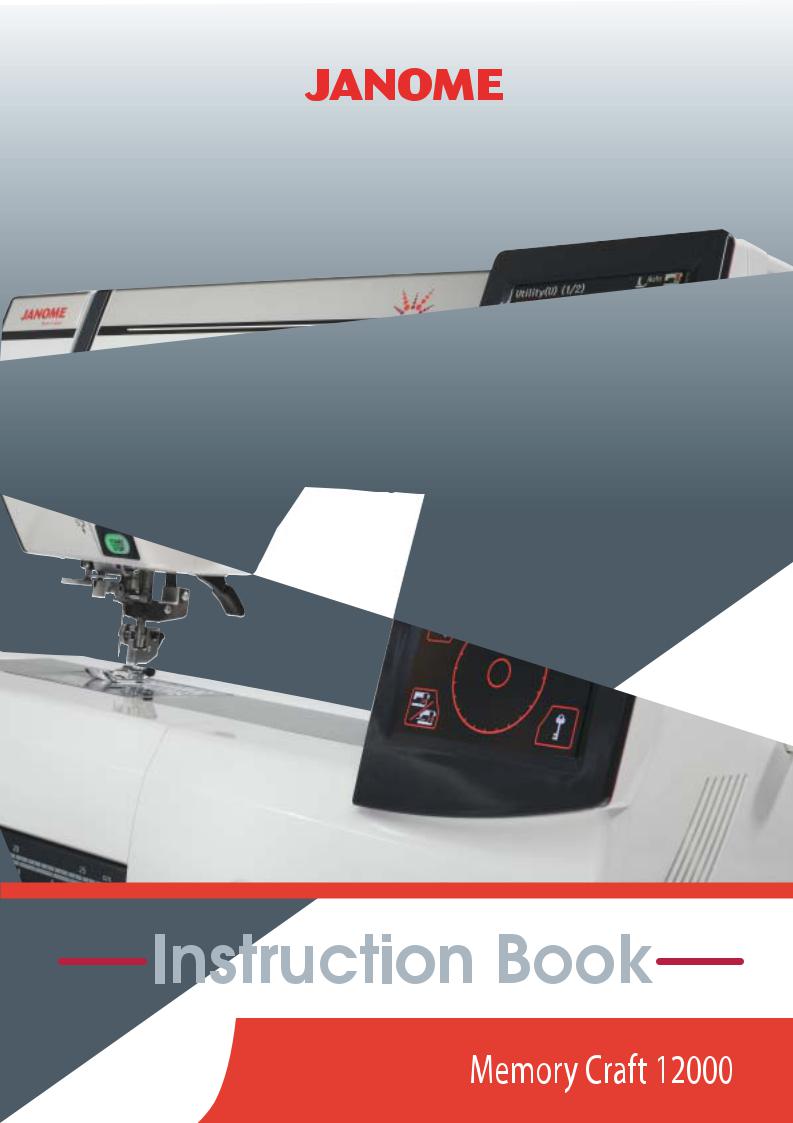

IMPORTANT SAFETY INSTRUCTIONS
This appliance is not intended for use by persons (including children) with reduced physical, sensory or mental capabilities, or lack of experience and knowledge, unless they have been given supervision or instruction concerning use of the appliance by a person responsible for their safety.
Children should be supervised to ensure that they do not play with this sewing machine.
When using an electrical appliance, basic safety precautions should always be followed, including the following:
This sewing machine is designed and manufactured for household use only.
Read all instructions before using this sewing machine.
DANGER— To reduce the risk of electric shock:
1.An appliance should never be left unattended when plugged in. Always unplug this sewing machine from the electric outlet immediately after using and before cleaning.
WARNING— To reduce the risk of burns, fire, electric shock, or injury to persons:
1.Do not allow to be used as a toy. Close attention is necessary when this sewing machine is used by or near children.
2.Use this appliance only for its intended use as described in this owner’s manual.
Use only attachments recommended by the manufacturer as contained in this owner’s manual.
3.Never operate this sewing machine if it has a damaged cord or plug, if it is not working properly, if it has been dropped or damaged, or dropped into water.
Return this sewing machine to the nearest authorized dealer or service center for examination, repair, electrical or mechanical adjustment.
4.Never operate the appliance with any air opening blocked. Keep ventilation openings of this sewing machine and foot controller free from accumulation of lint, dust and loose cloth.
5.Never drop or insert any object into any opening.
6.Do not use outdoors.
7.Do not operate where aerosol (spray) products are being used or where oxygen is being administered.
8.To disconnect, turn all controls to the off (“O”) position, then remove plug from outlet.
9.Do not unplug by pulling on cord. To unplug, grasp the plug, not the cord.
10.Keep fingers away from all moving parts. Special care is required around the sewing machine needle and/or cutting blade.
11.Always use the proper needle plate. The wrong plate can cause the needle to break.
12.Do not use bent needles.
13.Do not pull or push fabric while stitching. It may deflect the needle causing it to break.
14.Switch this sewing machine off (“O”) when making any adjustment in the needle area, such as threading the needle, changing the needle, threading the bobbin or changing the presser foot, and the like.
15.Always unplug this sewing machine from the electrical outlet when removing covers, lubricating, or when making any other adjustments mentioned in this owner’s manual.
SAVE THESE INSTRUCTIONS
The design and specifications are subject to change without a prior notice.
Please note that on disposal, this product must be safely recycled in accordance with relevant National legislation relating to electrical/electronic products. If in doubt please contact your retailer for guidance. (European Union only)
TABLE OF CONTENTS
GETTING READY TO SEW |
|
Names of Parts ......................................................................... |
1 |
Standard Accessories ............................................................... |
3 |
Extension Table ......................................................................... |
5 |
Accessory Storage .................................................................... |
5 |
Connecting the Power Supply ................................................... |
6 |
Controlling Sewing Speed ......................................................... |
7 |
Speed control slider ............................................................... |
7 |
Foot control ............................................................................ |
7 |
Extra Wide Table ....................................................................... |
7 |
Machine Operating Buttons ...................................................... |
8 |
Touch Panel Keys ..................................................................... |
9 |
Setting the Spool of Thread .................................................... |
10 |
Extra spool pin ..................................................................... |
10 |
Winding the Bobbin ................................................................. |
10 |
Removing the bobbin ........................................................... |
10 |
Winding the bobbin .............................................................. |
11 |
Inserting the bobbin .............................................................. |
12 |
Threading the Machine ........................................................... |
13 |
Needle threader ...................................................................... |
14 |
Drawing Up the Bobbin Thread ............................................... |
15 |
Replacing Needles .................................................................. |
16 |
Replacing the Presser Foot .................................................... |
17 |
Replacing the Foot Holder ...................................................... |
18 |
Replacing the Needle Plate .................................................... |
20 |
Raising and Lowering the Presser Foot .................................. |
21 |
Retractable Sewing Light ........................................................ |
22 |
Optic Magnifier ........................................................................ |
22 |
Automatic Foot Pressure Control ............................................ |
22 |
Mode Selection ....................................................................... |
23 |
On-screen Help Movie ............................................................ |
23 |
ORDINARY SEWING MODE |
|
Ordinary Stitch Patterns .......................................................... |
24 |
Function Keys in Ordinary Sewing Mode ................................ |
26 |
Utility Stitches.......................................................................... |
28 |
Straight stitches ...................................................................... |
28 |
Starting to sew ..................................................................... |
28 |
Sewing from the edge of thick fabric .................................... |
28 |
Changing sewing direction ................................................... |
28 |
Turning a square corner .......................................................... |
28 |
Securing seams ................................................................... |
29 |
Cutting threads ..................................................................... |
29 |
Using the seam guide lines .................................................. |
29 |
Variety of straight stitches .................................................... |
30 |
Sewing with the dual feed device ............................................ |
31 |
U8 Basting............................................................................... |
32 |
Zigzag stitches ........................................................................ |
32 |
Variety of overcasting stitches .............................................. |
33 |
Manual Stitch Settings ............................................................ |
34 |
Cloth guide .............................................................................. |
36 |
Other utility stitches ................................................................. |
37 |
Buttonholes and Specialty Stitches ......................................... |
39 |
Variety of buttonholes.............................................................. |
39 |
B1 Sensor (Square) buttonhole .............................................. |
40 |
Manual settings .................................................................... |
42 |
Using the Stabilizer Plate ........................................................ |
43 |
B2 Automatic (square) buttonhole ........................................... |
44 |
Other buttonholes ................................................................... |
46 |
B13 Welted buttonhole (Bound buttonhole) ......................... |
48 |
Corded buttonhole ................................................................ |
50 |
Specialty stitches .................................................................... |
50 |
B15 Darning ......................................................................... |
51 |
Fly stitches (B17 to B20) ...................................................... |
52 |
Eyelets (B21 to B25) ............................................................ |
52 |
Decorative Stitches ................................................................. |
54 |
Quilting(Q) ............................................................................... |
56 |
S1-S29 Decorative satin stitches ............................................ |
57 |
Created stitches (CS) .............................................................. |
58 |
Twin Needle Sewing ............................................................... |
59 |
Programming a Pattern Combination ...................................... |
60 |
Editing a pattern combination ................................................. |
61 |
Startover key ........................................................................ |
62 |
Monogramming ....................................................................... |
63 |
Programming a monogram .................................................. |
64 |
Saving a Pattern Combination ................................................ |
65 |
Opening a Pattern Combination .............................................. |
66 |
Sewing Application .................................................................. |
67 |
Seaming ............................................................................... |
68 |
Overedge ............................................................................. |
69 |
Blind hem ............................................................................. |
70 |
Shell tuck .............................................................................. |
71 |
Rolled hem ........................................................................... |
72 |
Zipper sewing ....................................................................... |
73 |
Concealed zipper sewing ..................................................... |
76 |
Button sewing ....................................................................... |
79 |
Tacking ................................................................................. |
80 |
Applique ............................................................................... |
81 |
Patchwork ............................................................................ |
82 |
Quilting ................................................................................. |
83 |
CUSTOMIZING MACHINE SETTINGS |
|
Common Setting Mode ........................................................... |
87 |
Ordinary Sewing Setting Mode ............................................... |
90 |
Correcting Deformed Stitch Patterns ...................................... |
94 |
EMBROIDERY MODE |
|
Embroidery Unit ...................................................................... |
96 |
Attaching the embroidery unit .............................................. |
96 |
Extending the carriage arm .................................................. |
97 |
Detaching the embroidery unit ............................................. |
98 |
Attaching the Embroidery Foot ............................................... |
99 |
Attaching the Straight Stitch Needle Plate ............................ |
100 |
Special Bobbin Holder for Embroidery .................................. |
101 |
Embroidery Hoops ................................................................ |
102 |
Stabilizers.............................................................................. |
103 |
Setting the Fabric in an Embroidery Hoop ............................ |
104 |
Attaching the Embroidery Hoop to the Machine ................... |
105 |
Selecting Built-in Embroidery Designs .................................. |
106 |
Monogramming ..................................................................... |
107 |
Function keys ..................................................................... |
108 |
Programming a monogram ................................................ |
109 |
2- Letter monogram ............................................................ |
110 |
Editing a monogram ............................................................ |
111 |
Ready to Sew Window .......................................................... |
112 |
Starting to sew embroidery ................................................... |
115 |
Fringed flower designs ....................................................... |
116 |
Lace designs ...................................................................... |
117 |
Quilting designs .................................................................. |
117 |
Editing Mode ......................................................................... |
118 |
Free arm embroidery .......................................................... |
125 |
Border designs ................................................................... |
126 |
CUSTOMIZING MACHINE SETTINGS |
|
Embroidery mode settings .................................................... |
128 |
FILE MANAGEMENT |
|
Saving and Opening a File .................................................... |
131 |
Saving a file ........................................................................ |
131 |
Creating a new folder ......................................................... |
132 |
Deleting a file or folder ....................................................... |
132 |
Opening the file .................................................................. |
132 |
Changing a name of the file or folder ................................. |
133 |
Direct PC-Link ....................................................................... |
133 |
CARE AND MAINTENANCE |
|
Cleaning the Hook Area ........................................................ |
134 |
Cleaning the Inside of the Thread Guide .............................. |
135 |
Troubleshooting .................................................................... |
136 |
STITCH CHART.................................................................... |
138 |
DESIGN CHART ................................................................... |
141 |

q |
w e |
r |
t |
GETTING READY TO SEW |
|
|
|
|
Names of Parts |
|
|
|
|
q Top cover |
|
|
|
y |
w Spool pin |
|
|
|
|
e Spool holder (Large) |
|
|
|
|
r Foot compartment |
|
|
|
|
t Thread cutter |
|
|
|
|
y Bobbin winder spindle |
|
|
|
|
u Thread take-up lever |
u |
|
|
q |
|
|
|
|
|
|
!4 |
|
|
|
i Visual touch screen |
|
|
|
|
|
|
|
|
|
o Knee lifter socket |
|
|
|
i |
!0Feed balancing dial cap |
!3 |
|
|
|
!1Extension table |
|
|
|
|
(accessory storage) |
|
|
|
|
!2Thread cutter/holder |
|
|
|
|
!3Face plate |
|
|
|
|
!4Retractable light |
!2
!1 |
!0 |
o |
|
||
|
|
|
@3 |
|
|
@2 |
|
|
@1 |
|
!5Hook cover release button |
!5 |
|
!6Hook cover |
@0 |
|
|
|
!7Needle plate |
|
!9 |
|
|
|
!8Presser foot |
|
|
|
!9Presser foot holder |
!6 |
|
@0Thumbscrew |
!8 |
|
@1Needle threader |
!7 |
|
@2Buttonhole lever |
@3Needle clamp screw
@9 |
|
|
@4Start/stop button |
|
@8 |
#0 |
@5Reverse button |
@5 |
|
@6Auto-lock button |
|
@7 |
|
||
|
|
@7Needle up/down button |
|
|
|
|
|
@4 |
@6 |
|
@8Presser foot lifter button |
|
|
@9Thread cutter button |
|
|
|
|
#0Speed control slider
1

u
i
o
q
 !4
!4
!0
w
e
y
r
t |
!1 |
|
!2
!3
q
w
e
q Hand wheel
w Dual feed balancing dial e USB ports
r Power switch t Power inlet
y Foot control jack u Carrying handle i Presser foot lifter o Dual feed drive
!0Embroidery unit socket !1Embroidery unit !2Carriage arm
!3Carriage arm release lever !4Cover
q Semi-hard fabric cover w Embroidery unit case e Extra wide table
2
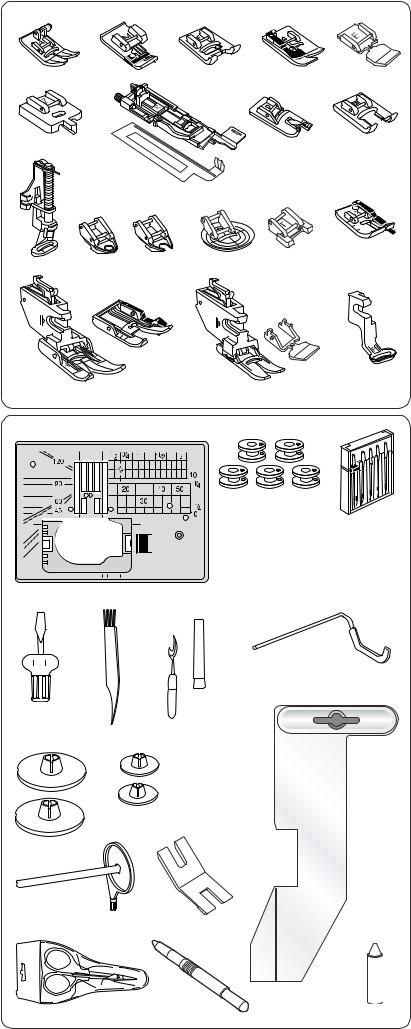
q |
w |
|
e |
r |
t |
y |
u |
|
o |
|
!0 |
|
i |
|
|
|
|
!1 |
|
|
|
|
|
|
!2 |
!3 |
!4 |
!5 |
!6 |
|
|
||||
|
|
|
|
||
!7 |
|
|
!8 |
|
@3 |
|
|
|
|
|
|
|
@1 |
|
|
@2 |
|
|
|
|
|
|
|
!9 |
|
|
@0 |
|
|
|
|
|
|
|
|
@4 |
|
|
@5 |
|
@6 |
y



@7 |
@8 |
@9 |
#0 |
|
|
#7
#1 #2
#5
#3
#4 |
#6 |
#8
Standard Accessories
q Zigzag foot A (set on the machine) w Overedge foot M
e Satin stitch foot F
r Blind hemming foot G t Zipper foot E
y Concealed zipper foot Z
u Automatic buttonhole foot R i Stabilizer plate
o Rolled hem foot D !0Open toe satin stitch foot F2 !1Darning foot PD-H
!2Free motion quilting closed-toe foot QC !3Free motion quilting open-toe foot QO !4Free motion quilting zigzag foot QV !5Button sewing foot T
!61/4” seam foot O !7Dual feed holder (twin) !8Dual feed holder (single) !9Dual feed foot AD (twin) @0Dual feed foot VD (single)
@1Dual feed quilt piecing foot OD (twin) @2Dual feed zipper foot ED (single) @3Embroidery foot P
@4Straight stitch needle plate @5Bobbins
@6Needle set @7Screwdriver @8Lint brush
@9Seam ripper (buttonhole opener) #0Quilting guide bar
#1Spool holders (large) #2Spool holders (small) #3Extra spool pin #4Scissors
#5Button shank plate #6Touch panel stylus #7Cloth guide #8Bobbin holder cleaner
3
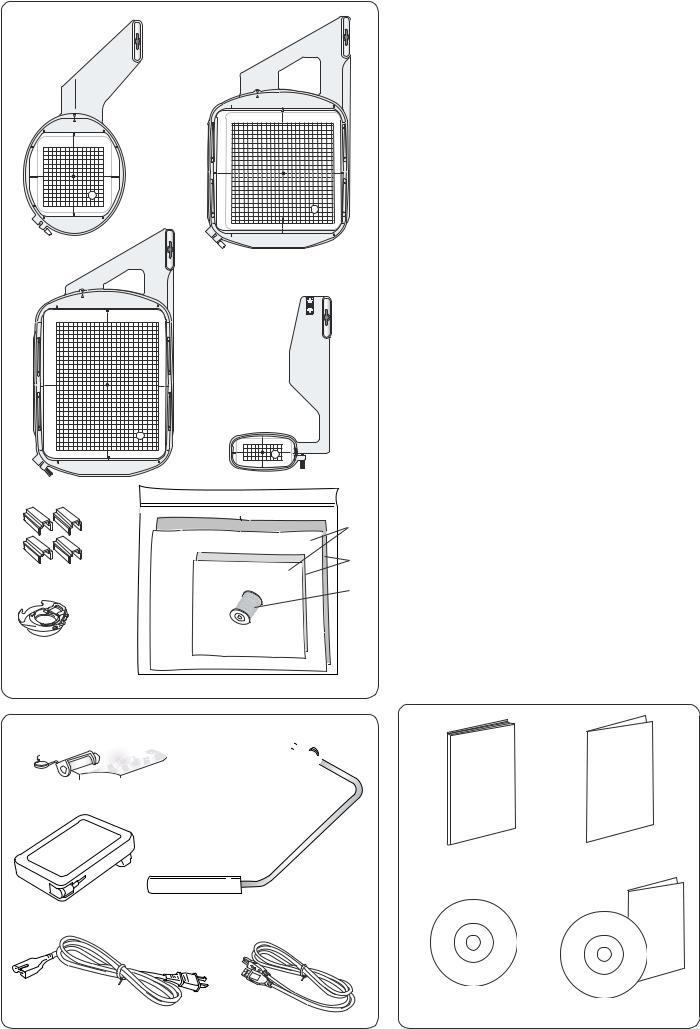
|
q Embroidery hoop SQ14 (with template) |
|
|
w Embroidery hoop SQ23 (with template) |
|
|
e Embroidery hoop GR (with template) |
|
w |
r Embroidery hoop FA10 (with template) |
|
t Magnetic clamps |
||
q |
y Bobbin holder for embroidery |
|
|
||
|
u Felts |
|
|
i Stabilizers |
|
|
o Bobbin thread for embroidery |
|
|
!0Optic magnifier |
|
|
!1Foot control |
|
|
!2Knee lifter |
|
e |
!3Power cable |
|
!4USB cable |
||
|
||
|
!5Instruction book |
|
|
!6Key icon reference chart |
|
|
!7Instructional video DVD |
|
|
!8Horizon Link CD-ROM (with installation guide) |
t
u
i
y |
o |
|
!0

 !5 !6
!5 !6
!1 |
|
|
!2 |
|
!7 |
|
!8 |
!3 |
!4 |
|
4

y |
q |
w |
|
e r 

 t
t
q |
w |
e |
r |
t |
y |
q
e 

 w
w
t


 r
r
Extension Table
The extension table provides an extended sewing area and can be removed for free arm sewing.
To remove:
Draw the table to the left.
To attach:
Slide the table on the base and push it to the right.
Free arm sewing
The free arm is used for stitching sleeves, waistbands, pant legs or any other tubular garments.
It is also useful for darning socks or elbows.
Accessory Storage
The accessories can be conveniently stored in the compartment under the top cover and in the extension table.
Under the top cover q Zigzag foot A
w Satin stitch foot F e Overedge foot M
r Blind hemming foot G t Zipper foot E
y Touch panel stylus
In the extension table
Push up the latch to open the compartment cover. q Latch
w Straight stitch needle plate (Place it upside down.) e Automatic buttonhole foot R (with stabilizer plate) r Extra spool pin
t Bobbins
Other accessories can be stored in the compartment under the cover.
5

q
w
e
t
r
Operating Instructions:
Foot controller Model 21371 is for use with sewing machine model MC 12000.
Connecting the Power Supply
First make sure the power switch is off. Insert the machine plug into the power inlet.
Insert the power supply plug into the wall outlet and turn the power switch on.
q Power switch w Machine plug e Power inlet
NOTE:
Make sure to use the power cable that came with the machine.
If you turn off the power switch, wait for 5 seconds before turning it on again.
If you wish to use the foot control, pull out the cord from the foot control and insert the pin connector into the jack on the machine.
r Foot control cord t Pin connector
Insert the machine plug of the power supply cable into the power inlet.
Insert the power supply plug into the wall outlet, and turn the power switch on.
 CAUTION:
CAUTION:
Do not pull the foot control cord beyond the red mark.
NOTE:
The foot control cannot be used in the embroidery mode.
 WARNING:
WARNING:
When running the machine, always keep your eyes on the sewing area, and do not touch any moving parts such as the thread take-up lever, hand wheel or needle. Always turn off the power switch and unplug the machine from the power supply:
-when leaving the machine unattended.
-when attaching or removing parts.
-when cleaning the machine.
Do not place anything on the foot control.
Operating Instructions:
The symbol “O” on a switch indicates the “off” position of the switch.
For the U.S.A. and Canada only
Polarized plug (one blade wider than the other):
To reduce the risk of electric shock, this plug is intended to fit in a polarized outlet only one way. If it does not fit fully in the outlet, reverse the plug. If it still does not fit, contact a qualified electrician to install the proper outlet. Do not modify the plug in any way.
6
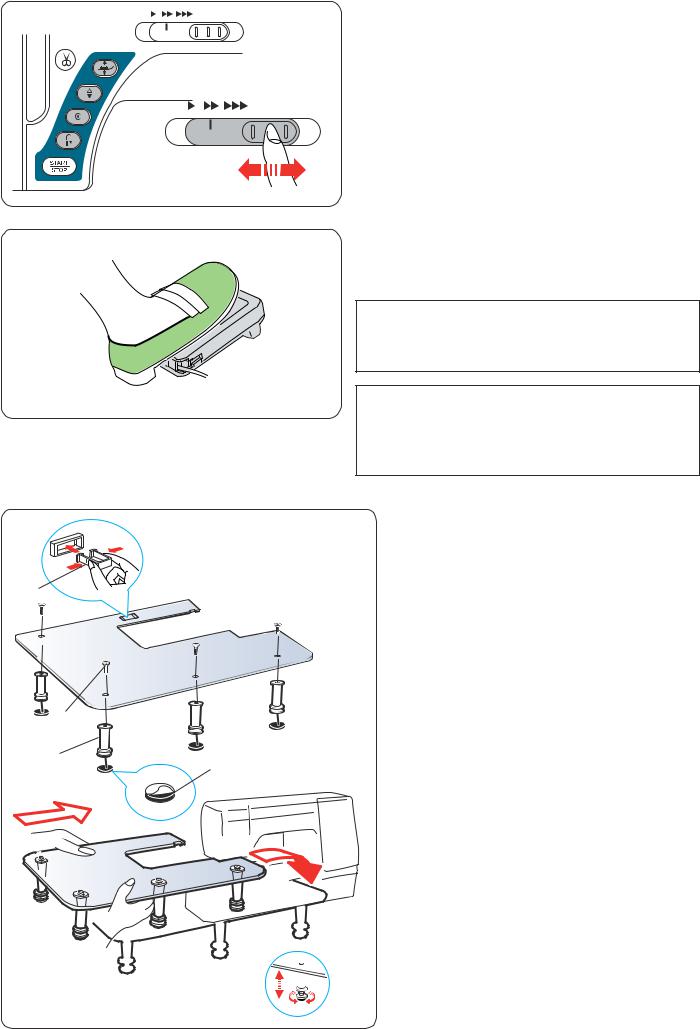
Controlling Sewing Speed
Speed control slider
You can limit the maximum sewing speed in both the ordinary sewing mode and embroidery mode with the speed control slider according to your sewing needs.
To increase the sewing speed, move the slider to the right.
To decrease the sewing speed, move the slider to the left.
The sewing speed can be changed while stitching.
Foot control
Pressing on the foot control can vary sewing speed. The harder you depress the foot control, the faster the machine runs.
NOTE:
The machine runs at the maximum speed set by the speed control slider when the foot control is fully depressed.
NOTE:
This machine is equipped with an automatic
shutdown safety feature to prevent overheating whenever the machine is running overloaded. Follow the safety instructions that appear on the visual touch screen.
|
Extra Wide Table |
|
|
Peel off the backing paper from the rubber soles |
|
r |
and attach to the bottom of the legs |
|
q Rubber sole |
||
|
w Leg |
|
|
Attach the 4 legs to the table top with the setscrew. |
|
|
Attach the table support to the underside of the |
|
|
table by inserting the hooks into the slots. |
|
e |
e Setscrew |
|
r Table support |
||
|
||
w |
Remove the extension table. |
|
q |
||
|
Place the assembled table on the machine. |
|
|
Adjust the table height by turning the adjusting |
|
|
screws. |
|
|
t Adjusting screw |
t
7
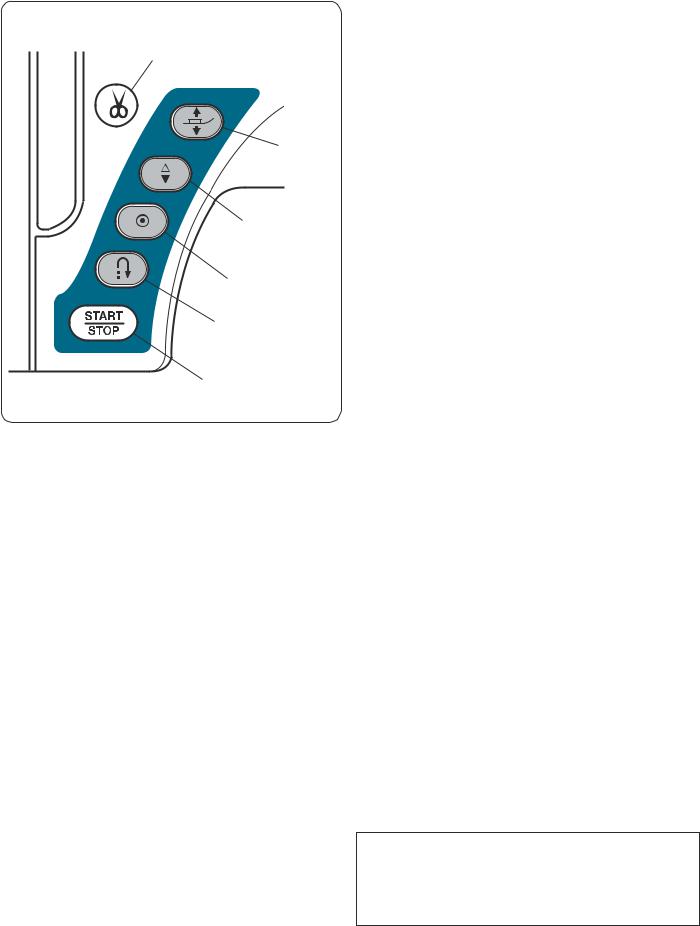
|
|
Machine Operating Buttons |
|
|
q Start/stop button |
y |
|
Press this button to start or stop the machine. This button |
|
|
can be used either in the ordinary sewing mode or |
|
|
embroidery mode. |
|
|
In the ordinary sewing mode, the machine starts running |
|
|
slowly for the first few stitches it then runs at the speed |
tset by the speed control slider.
|
The machine runs slowly as long as this button is being |
|
|
pressed. |
|
|
The button turns red when the machine is running, and |
|
r |
green when it stops. |
|
|
|
|
|
NOTE: |
|
e |
The start/stop button cannot be used in the ordinary |
|
|
sewing mode when the foot control is connected. |
|
w |
w Reverse button |
|
|
||
|
When sewing stitch pattern U1, U4, U9-12, Q1-3 or |
|
q |
BR1-10, the machine will sew in reverse as long as the |
|
reverse button is pressed. |
||
|
||
|
If stitch pattern U1, U4, U9-12, Q1-3 or BR1-10 has been |
|
|
selected and the foot control is not connected, the |
|
|
machine will start sewing in reverse as long as the |
|
|
reverse button is pressed. |
|
|
If you press the reverse button when sewing any other |
|
|
patterns, the machine will immediately sew locking |
|
|
stitches and automatically stop. |
e Auto-lock button
When sewing stitch pattern U1, U4, U9-12, Q1-3 or BR1-10, the machine will immediately sew locking stitches and automatically stop when the auto-lock button is pressed.
When sewing all other patterns, the machine will sew to the end of the current pattern, sew locking stitches and stop automatically.
The machine will trim the threads automatically after locking the stitch when the auto thread cutting option is turned on (refer to page 90).
r Needle up/down button
The machine will always stop with the needle down except when buttonholes, darning, tacking, eyelets or monograms are selected.
Press this button to bring the needle bar up or down.
t Presser foot lifter button
The presser foot will go up or go down by pressing this button.
You can use also the presser foot lifter and knee lifter to raise and lower the presser foot.
y Thread cutter button
Press this button when you finish sewing to trim the threads. The needle bar and presser foot automatically rise after trimming the threads.
Refer to page 29.
NOTES:
The thread cutter button does not function:
-soon after turning on the power.
-when the presser foot is raised with the foot lifter.
-when being pressed 4 times in a row.
8
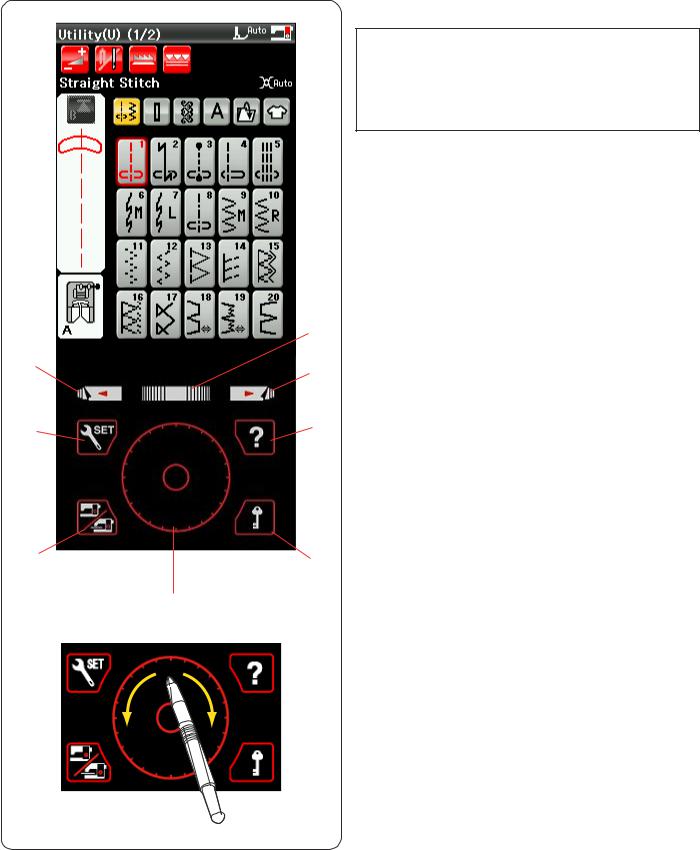
Touch Panel Keys
 CAUTION:
CAUTION:
|
|
Do not press the touch panel or visual touch screen with |
|
|
hard or sharp objects like pencils, screwdrivers or the like. |
|
|
Use the touch panel stylus included in the standard |
|
|
accessories. |
|
|
q Set mode key |
|
|
Press this key to enter the setting mode. You can |
|
|
customize the machine settings to your preference. |
|
|
The machine settings for common settings, ordinary |
|
|
sewing, embroidery and language selection are available |
|
|
in this mode. |
|
|
w Help movie key |
|
|
Press this key to view the on-screen movie about the |
|
y |
essential operations. |
|
|
|
t |
t |
e Mode switch key |
|
Press this key to enter into embroidery mode or to return |
|
|
|
|
|
|
to ordinary sewing mode. |
q |
w |
r Lockout key |
|
||
|
|
|
|
|
Press this key to lockout the machine when threading the |
|
|
machine, replacing the accessories etc. |
|
|
To reduce the risk of injury, all the buttons and keys |
|
|
except for the presser foot lifter button are deactivated. |
|
|
To unlock the machine, press this key again. |
e |
r |
t Page keys |
|
||
|
|
Press the page key to display the next page or previous |
|
u |
page. Press and hold the page key to turn the pages |
|
|
continuously. |
|
|
y Touch bar |
|
|
Press on the bar and slide to the right or left to display |
|
|
the next page or previous page. |
|
|
u Touch ring |
|
|
Trace the ring clockwise or counterclockwise with your |
|
|
finger tip or use the touch panel stylus to browse items |
|
|
displayed on the visual touch screen. |
9
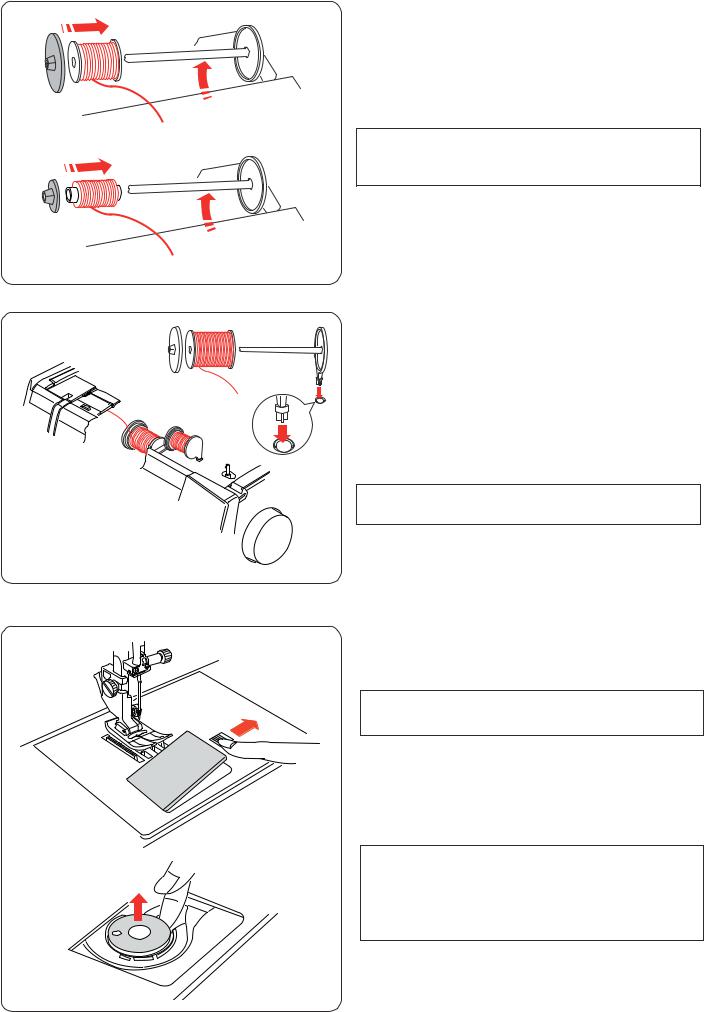
Setting the Spool of Thread
Open the top cover.
Lift up the spool pin. Place the spool of thread on the spool pin.
Attach the large spool holder, and press it firmly against the spool of thread.
NOTE:
Use the small spool holder to hold narrow or small spools of thread.
Extra spool pin
Use the extra spool pin when you need to wind a bobbin without unthreading the machine while working on a sewing project.
Insert the extra spool pin into the hole in the foot compartment as shown.
Place a spool of thread on the extra spool pin and fix the spool with the spool holder.
NOTE:
The extra spool pin is also used for twin needle sewing.
Winding the Bobbin
z
Removing the bobbin
 CAUTION:
CAUTION:
Press the lockout key or turn the power switch off.
z Slide the hook cover release button to the right, and remove the hook cover.
x Remove the bobbin from the bobbin holder.
NOTE:
x
Use the Janome plastic bobbins for horizontal hook (marked with a “J”). Using other bobbins, such as pre-wound paper bobbins, may cause stitching problems and/ or damage to the bobbin holder.
10
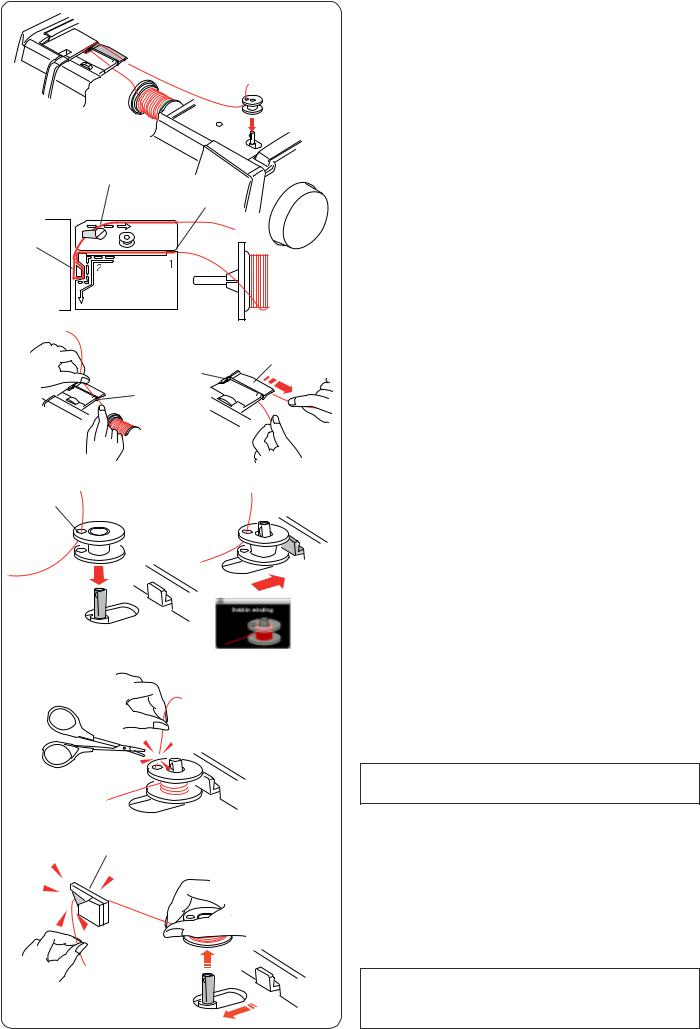
Winding the bobbin
e
q
w |
|
|
z Pull the thread from the spool. |
|
|
Hold the thread with both hands and pass the thread |
|
|
|
|
|
|
|
|
into the guide slot. |
|
|
|
q Guide slot |
|
|
|
x Draw the thread to the left and forward around the |
z |
x |
e |
thread guide. |
|
w |
Draw the thread to the rear and to the right around |
|
|
|
||
|
|
and under the guide plate. |
|
|
q |
|
|
|
|
Firmly pull the thread to the right while holding it |
|
|
|
|
|
|
|
|
with both hands. |
|
|
|
w Thread guide |
|
|
|
e Guide plate |
|
r |
|
c Pass the thread through the hole in the bobbin from |
c |
|
|
the inside to the outside. |
|
|
|
Turn the power switch on. Put the bobbin on the |
|
|
|
bobbin winder spindle. |
|
|
|
Push the bobbin to the right. |
|
|
|
The LCD screen will show the bobbin winding sign. |
|
|
|
r Hole |
|
|
|
v Hold the free end of the thread in your hand and |
v |
|
|
start the machine. |
|
|
Stop the machine when the bobbin has wound a few |
|
|
|
|
|
|
|
|
layers, and cut the thread close to the hole in the |
|
|
|
bobbin. |
|
|
|
NOTE: |
|
|
|
Set the speed control slider to the fastest position. |
|
|
|
b Start the machine again. |
|
t |
|
Stop the machine when the bobbin is fully wound |
b |
|
|
and stops spinning. |
|
|
Return the bobbin winder spindle to its original position. |
|
|
|
|
|
|
|
|
Remove the bobbin and cut the thread with the thread |
|
|
|
cutter. |
|
|
|
t Thread cutter |
|
|
|
NOTE: |
|
|
|
For safety purposes, the machine will automatically stop |
|
|
|
1.5 minutes after starting bobbin winding. |
11
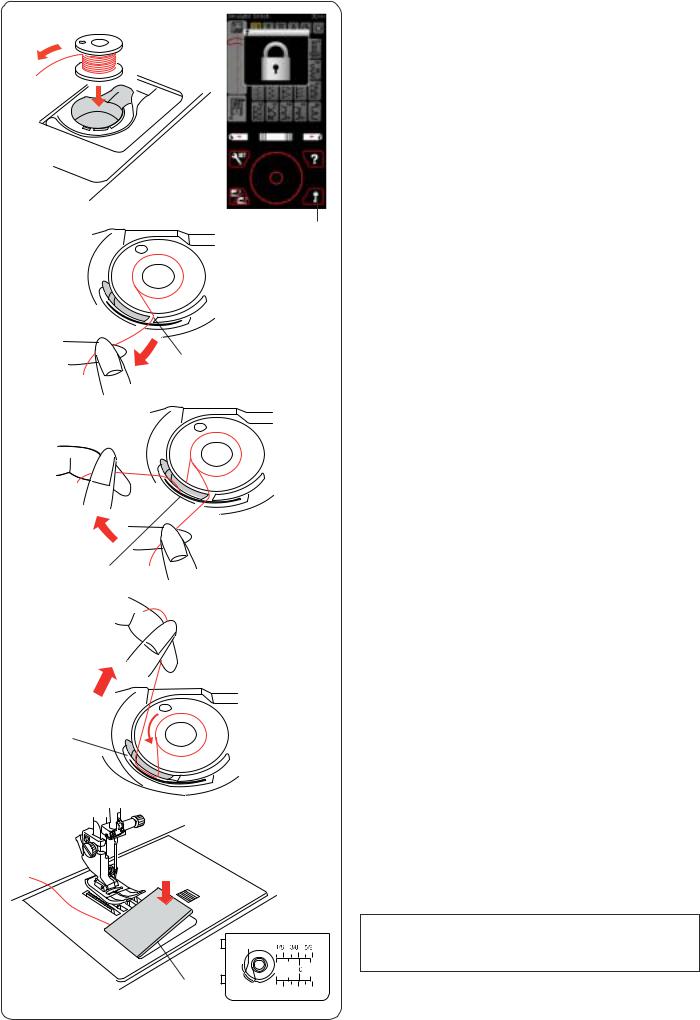
Inserting the bobbin
z
z Press the lockout key. Place the bobbin in the bobbin holder with the thread running off counterclockwise. q Lockout key
x |
q |
x Guide the thread into the front notch on the bobbin |
|
||
|
|
holder. |
|
|
w Front notch |
w
c Draw the thread to the left, sliding it between the c  tension spring blades.
tension spring blades.
e Tension spring blades
|
e |
v |
v Continue to draw the thread gently until the thread |
|
slips into the side notch. |
|
r Side notch |
r
b |
b Pull out about 10 cm (4”) of thread to the rear. |
|
Reattach the hook cover plate. |
|
Press the lockout key to unlock the machine. |
|
t Hook cover |
|
NOTE: |
|
The threading chart is shown on the hook cover for your |
|
reference. |
t
12

x |
Threading the Machine |
|
Press the needle up/down button to raise the take-up lever |
||
z |
||
to the highest position. |
||
v |
Press the lockout key to lockout the machine. The presser |
|
foot will go down and the upper thread tension disks will |
||
|
||
|
open. |
|
|
q Lockout key |
|
|
Pass the thread in the order from z to m. |
b  c n
c n
m
z
z Hold the thread with both hands and pass the thread
|
|
|
q |
into the guide slot. |
|
|
|
w Guide slot |
|
|
|
|
|
|
|
|
w |
|
|
|
x |
|
|
x Draw the thread to the left and around the corner of |
|
|
|
the guide toward you. |
|
|
|
|
|
|
|
e |
|
|
Pull the thread along the right channel. |
|
|
|
|
e Corner of the guide |
|
|
|
|
r Right channel |
c |
r |
|
|
c Draw the thread down along the right channel and |
r |
|
|
around the bottom of the thread guide plate. |
|
|
|
|
||
|
|
|
|
Pull the thread up along the left channel. |
|
|
|
|
r Right channel |
y |
|
|
|
t Thread guide plate |
|
|
|
y Left channel |
|
|
|
|
|
|
|
v |
u |
|
v While holding the thread at the spool, firmly draw the |
|
t |
|
thread up and to the back of the take-up lever. Draw |
|
|
|
|
||
|
|
|
|
the thread forward to draw it into the eye of the take-up |
|
|
|
|
lever. |
|
|
|
|
u Eye of the take-up lever |
|
i |
|
|
|
b |
|
|
|
b Then pull the thread down along the left channel |
n |
|
|
|
|
|
|
|
and through the lower thread guide. |
|
m |
|
|
|
i Lower thread guide |
o |
n Slide the thread behind the needle bar thread guide |
|
|
|
from the left. |
|
o Needle bar thread guide |
|
m Thread the needle with the needle threader (refer to |
|
the next page). |
13
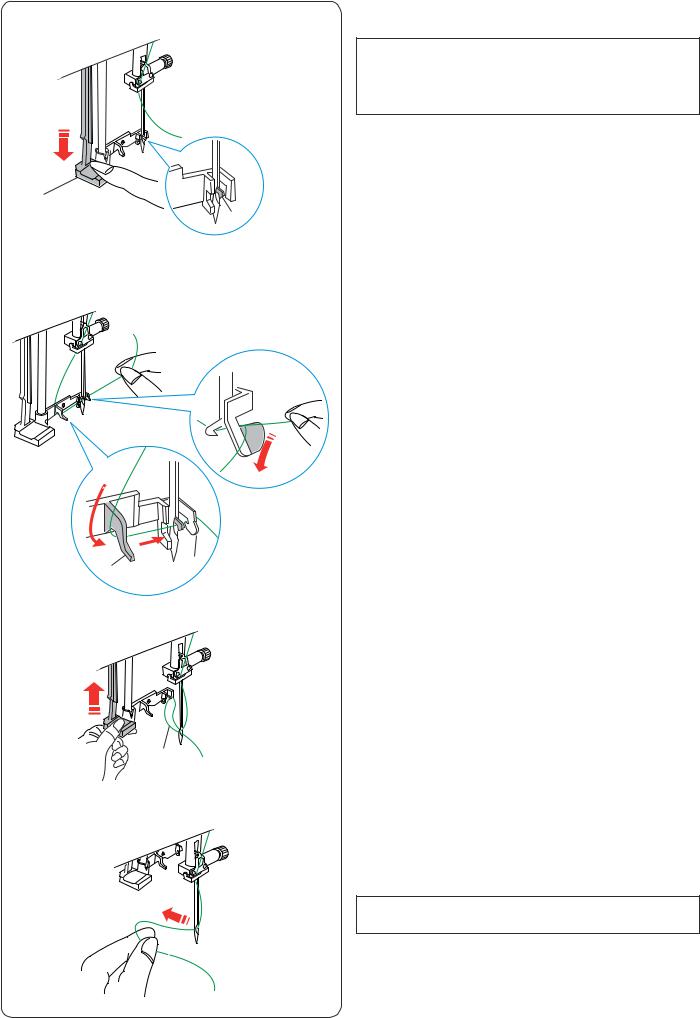
|
Needle threader |
|
z |
NOTE: |
|
The needle threader can be used with a #11 to #16 |
||
|
||
|
needle. |
|
|
Thread size 50 to 90 is recommended. |
|
|
Make sure the machine is locked out. |
|
|
z Pull down the needle threader knob as far as it will go. |
|
q |
The threader hook comes out through the needle eye |
|
w |
from behind. |
|
|
q Threader knob |
|
|
w Threader hook |
x
x Draw the thread from the left to the right, under the left
guide, threader hook and right guide.
Draw the thread around the right guide toward you. e Left guide
r Right guide
er
c
c Raise the threader slowly so a loop of the thread is pulled up through the needle eye.
t Thread loop
t
v
v Pull the thread loop to take the thread end out through the needle eye to the rear.
NOTE:
The needle threader cannot be used with the twin needle.
14

|
Drawing Up the Bobbin Thread |
z |
Press the lockout key to unlock the machine. The presser |
foot will go up. |
|
|
z Hold the needle thread with your finger and press |
|
the needle up/down button twice to pick up the |
|
bobbin thread. |
q |
q Needle up/down button |
x |
x Draw up the needle thread to bring up a loop of the |
|
bobbin thread. |
||
|
c |
c Slide 10 cm (4") of both threads to the rear under |
|
the presser foot. |
||
|
15
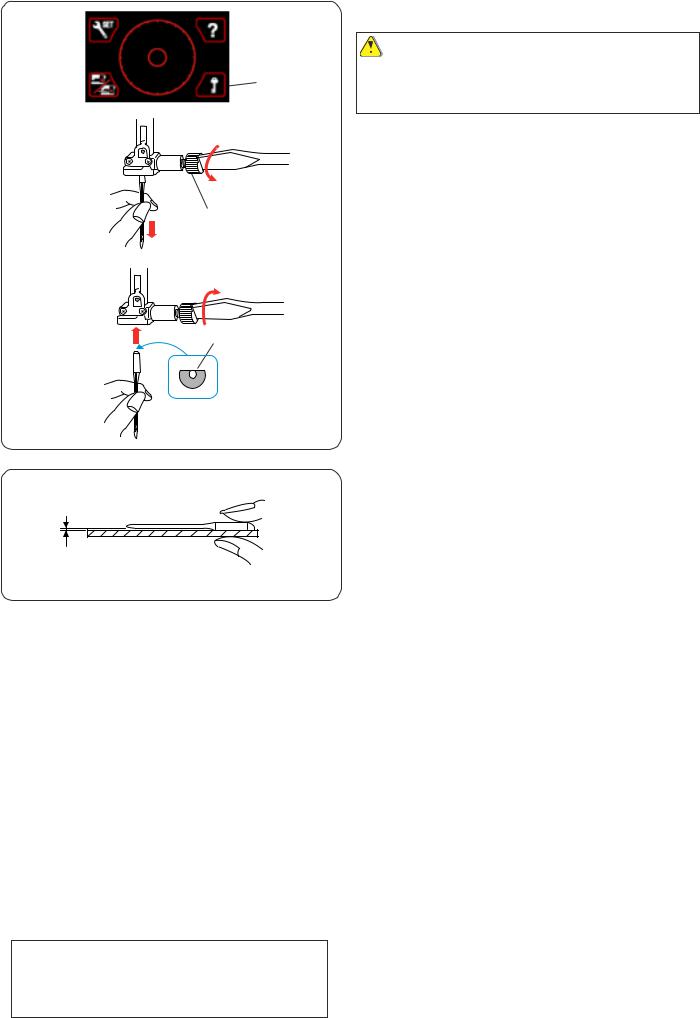
|
Replacing Needles |
|
|
CAUTION: |
|
q |
Always make sure to press the lockout key to lockout the |
|
machine or turn the power switch off before replacing the |
||
|
needle. |
|
|
Raise the needle by pressing the needle up/down button. |
|
|
Press the lockout key. |
|
|
q Lockout key |
|
w |
Loosen the needle clamp screw by turning it counter- |
|
|
clockwise. |
|
|
Remove the needle from the clamp. |
|
|
w Needle clamp screw |
|
|
Insert a new needle into the needle clamp with the flat |
|
e |
side of the needle to the rear. |
|
e Flat side |
||
|
||
|
When inserting the needle into the needle clamp, push it |
|
|
up against the stopper pin and tighten the needle clamp |
|
|
screw firmly with a screwdriver. |
|
|
To check needle straightness, place the flat side of the |
|
|
needle onto something flat (a needle plate, glass etc.) |
|
|
The gap between the needle and the flat surface should |
|
r |
be consistent. |
|
|
r Gap |
|
|
Never use a blunt needle. |
Fabric |
Thread |
Needle |
||
|
|
|
|
|
|
Lawn |
Silk #80-100 |
#9/65-11/75 |
|
Fine |
Georgette |
Cotton #80-100 |
||
Blue needle |
||||
|
Tricot |
Synthetic #80-100 |
||
|
|
|||
|
|
|
|
|
|
Sheeting |
Silk #50 |
|
|
|
Jersey |
#11/75-14/90 |
||
Medium |
Cotton #50-80 |
|||
Wool |
Red needle |
|||
|
Synthetic #50-80 |
|||
|
Knit |
|
||
|
|
|
||
|
|
|
|
|
|
Denim |
Silk #30-50 |
|
|
Heavy weight |
Tweed |
#14/90-16/100 |
||
Cotton #40-50 |
||||
Coating |
Purple needle |
|||
|
Synthetic #40-50 |
|||
|
Quilting |
|
||
|
|
|
||
|
|
|
|
|
NOTE:
1 x twin needle, 2 x blue needle (#11/75), 1 x red needle (#14/90) and 1 x purple needle (#14/90) are included in the needle case.
Fabric and Needle Chart
•For general sewing, use needle size #11/75 or #14/90.
•Fine threads and needles should be used for sewing fine fabrics.
•In general, use the same thread for both needle and bobbin.
•Use a blue needle for sewing fine fabrics, stretch fabrics and buttonholes to prevent skipped stitches.
•Use a purple needle for sewing thick fabrics, denims and across the hem to prevent skipped stitches.
•Use a stabilizer or interface to stretch or fine fabrics to prevent seam puckering.
•Always test the thread and needle size on a small piece of the same fabric you will use for actual sewing.
For embroidery:
•In general, use a blue needle
•Use a red needle for dense stitch embroidery.
•Janome bobbin thread for embroidery is recommended for bobbin.
16
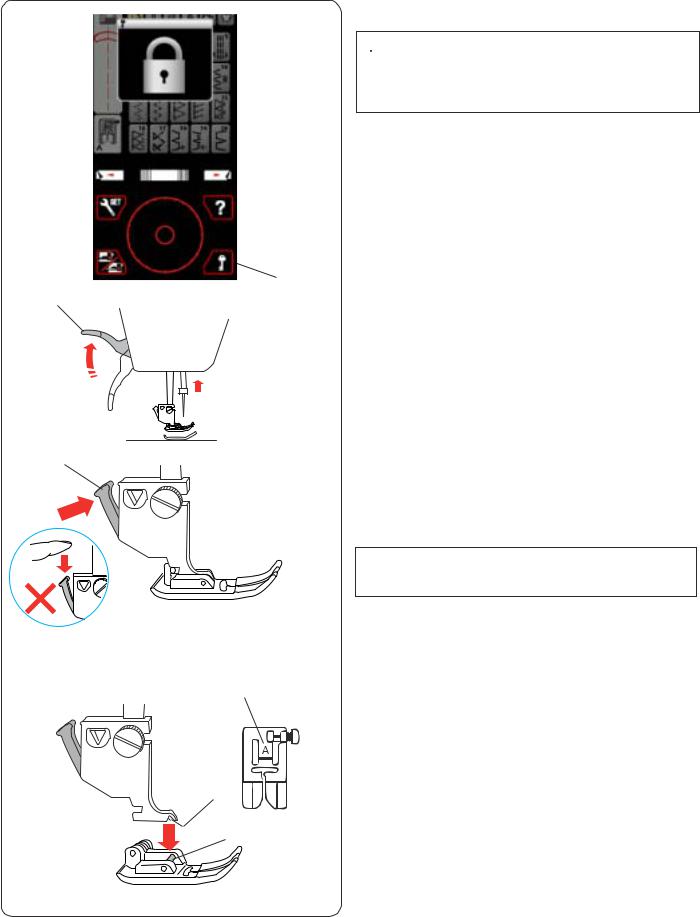
Replacing the Presser Foot
 CAUTION:
CAUTION:
Always make sure to press the lockout key to lockout the machine or turn the power switch off before replacing the presser foot.
Raise the needle by pressing the needle up/down button. Press the lockout key.
q Lockout key
q
w
Raise the presser foot lifter. w Presser foot lifter
e
Press the black lever on the backside of the foot holder. The presser foot will snap off.
e Lever
 CAUTION
CAUTION
To avoid damaging the lever, do not push it down.
y |
|
|
Place the desired foot under the foot holder so that the |
|
pin of the foot lies just under the groove of the foot holder. |
|
Lower the presser foot lifter to lock the foot in place. |
|
r Pin |
t |
t Groove |
r |
Each foot is marked with an identification letter. |
|
y Identification letter |
17
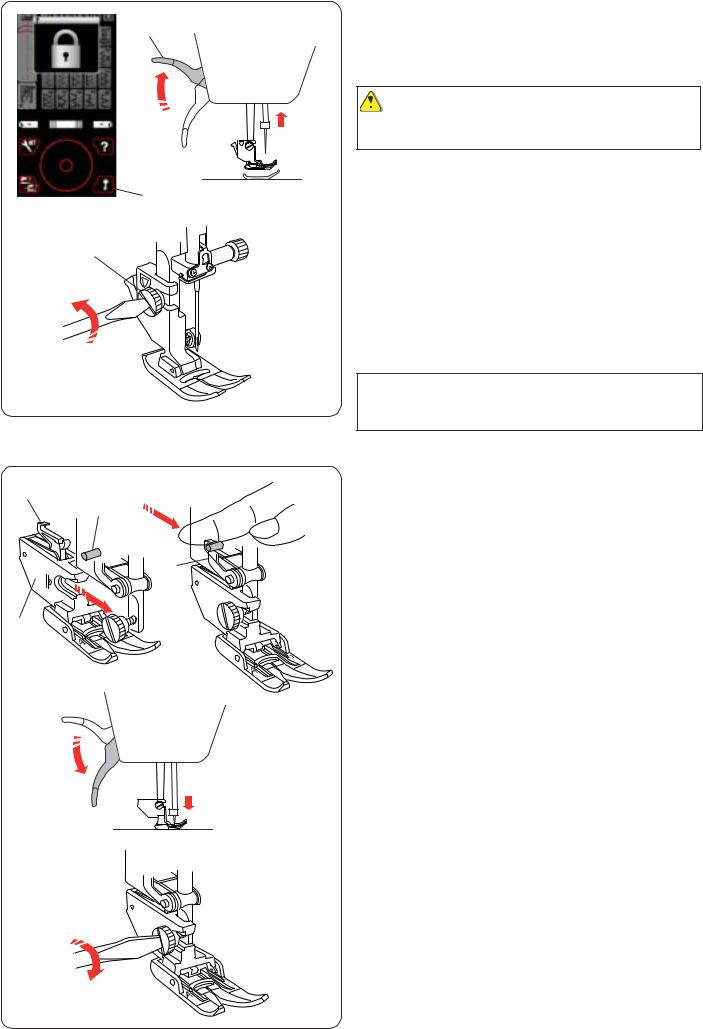
Replacing the Foot Holder
w
Replace the foot holder, if you use the dual feed feet, darning foot or embroidery foot.
|
CAUTION: |
|
Press the lockout key to lockout the machine before |
|
replacing the foot holder. |
|
Removing the presser foot holder |
q |
Raise the needle by pressing the needle up/down button. |
|
Press the lockout key and raise the presser foot with the |
|
presser foot lifter. |
e |
q Lockout key |
|
w Presser foot lifter |
|
Loosen the thumbscrew and remove the presser foot |
|
holder. |
|
e Thumbscrew |
|
NOTE: |
|
Use the foot holders included in the standard accessories |
|
only. |
|
Attaching the dual feed holder |
w |
Attach the dual feed holder to the presser bar. |
e |
q Dual feed holder |
|
|
w |
Tighten the thumbscrew with your figers. |
Push the dual feed link to engage it with upper feed drive. |
|
|
w Dual feed link |
|
e Upper feed drive |
q
Lower the presser foot lifter. Lower the needle to the lowest position by turning the hand wheel.
Tighten the thumbscrew securely with the screwdriver.
18

Detaching and attaching the dual feed foot
Pull the foot toward you to remove it.
Insert the pins of the foot into the slits of the foot holder and gently push the foot until it snaps into place.
q Pin
w Slit
w
q
q |
Attaching the darning foot PD-H |
|
Attach the darning foot PD-H to the presser bar by putting |
||
|
||
w |
the pin on the needle clamp screw. |
|
|
q Pin |
|
|
w Needle clamp screw |
|
|
Tighten the thumbscrew firmly with the screwdriver. |
Attaching the embroidery foot P
Attach the embroidery foot P to the presser bar from behind.
Refer to page 99.
19

Replacing the Needle Plate
Use the straight stitch needle plate when sewing with the dual feed foot and also when embroidering.
 CAUTION:
CAUTION:
|
|
Press the lockout key to lockout the machine before |
|
|
replacing the needle plate. |
|
|
Raise the needle and press the lockout key. |
|
|
|
|
|
Press the presser foot lifter button to raise the presser |
q |
|
foot. |
|
|
q Lockout key |
|
|
Slide the extension table to the left to remove it. |
|
|
Push down the needle plate release lever and the needle |
|
|
plate will snap off. |
|
|
w Needle plate release lever |
|
|
A message will appear warning that the needle plate is |
|
|
not secured. |
|
|
Remove the needle plate to the right. |
w
Place the straight stitch needle plate on the machine.
Set the left edge of the needle plate into the opening.
Push down on the mark of the needle plate until it locks in place.
Make sure the warning message disappears and the straight stitch is automatically selected.
Turn the hand wheel slowly and make sure that the needle does not hit the needle plate.
Press the lockout key to unlock.
 CAUTION:
CAUTION:
Never press the needle plate release lever while running the machine.
20
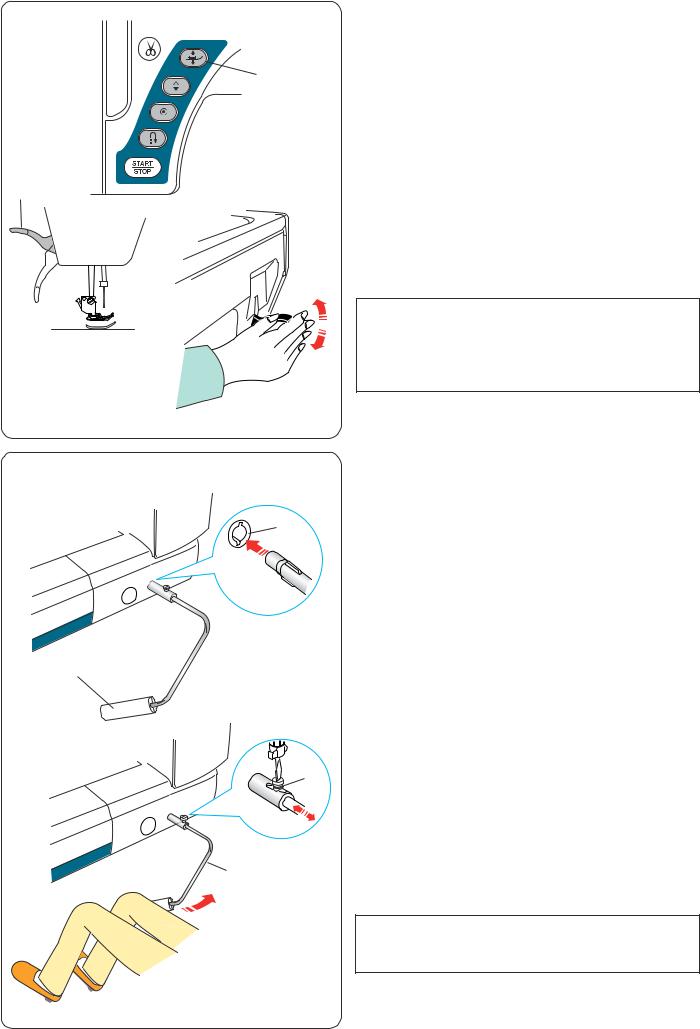
Raising and Lowering the Presser Foot
The presser foot automatically goes down when you begin sewing.
q However, you can raise and lower the presser foot with the presser foot lifter button, the presser foot lifter or the knee lifter.
q Presser foot lifter button w Presser foot lifter
w |
You can raise the presser foot about 6 mm (1/4”) higher |
|
than the normal up position by exerting more pressure |
|
when lifting the presser foot lifter or knee lifter. |
|
This helps you to place layers of thick fabrics or |
|
embroidery hoops under the foot. |
NOTE:
The presser foot cannot be lowered with the presser foot lifter if the foot was raised with the presser foot lifter button.
The knee lifter cannot be used in the embroidery mode.
Knee lifter
The knee lifter is extremely helpful when sewing patchwork, quilting etc., since it allows you to handle the
fabric while your knee controls the presser foot.
w
Attaching the knee lifter
Match the ribs on the knee lifter with the notches in the knee lifter socket and insert the knee lifter.
q Knee lifter
w Knee lifter socket
q |
Adjusting the knee lifter |
|
The angle of knee lifter can be adjusted to fit your knee. |
||
|
||
|
Loosen the setscrew and slide the angle bar in or out to |
|
|
adjust the angle of the knee lifter. |
|
|
Tighten the setscrew to secure the angle bar. |
|
|
e Setscrew |
|
e |
r Angle bar |
|
Using the knee lifter |
|
Push the knee lifter with your knee to move the presser |
|
foot up and down. |
r |
The knee lifter controls zigzag width of the variable |
|
zigzag (refer to page 85). |
NOTE:
Do not touch the knee lifter while stitching, otherwise the fabric will not be fed smoothly.
21

Retractable Sewing Light
|
q |
In addition to the twin LED lights, the machine is |
|
|
|
|
|
equipped with a retractable light. |
|
|
Slide the arm toward you by pulling the small tab on the |
|
|
arm. The light will turn on automatically. |
|
|
Adjust the angle of the light to illuminate the working |
|
|
area. |
|
|
q Small tab |
|
|
Push back the arm to turn the light off and store it. |
|
|
CAUTION: |
|
|
Do not hit or exert excessive force to the arm of the |
|
|
retractable sewing light to avoid damage when it is |
|
|
extended. |
|
|
Optic Magnifier |
|
|
Use the magnifier to get a larger view of the needle area. |
w |
|
Attaching the magnifier |
|
Hold the knob with your fingers and insert the pin into the |
|
|
|
|
q |
|
hole in the bottom of the face plate. |
|
|
Push the magnifier up until it snaps to fit. |
|
|
Adjust the angle to get the best view. |
|
|
q Pin |
|
|
w Hole |
|
|
Removing the magnifier |
|
|
If the magnifier is not in use, turn it to the left out of sight |
|
|
or pull it down to remove. |
|
|
CAUTION: |
|
|
Do not use or leave the magnifier in the direct sunlight, |
|
|
otherwise it may cause a fire or burn. |
|
|
Do not hit or exert excessive force to the optic magnifier |
|
|
to avoid damaging it when it is attached. |
Automatic Foot Pressure Control
The presser foot pressure is automatically optimized for each stitch pattern.
However you can adjust the foot pressure to suit your specific sewing need in the setting mode (refer to page 91).
22

|
|
|
|
Mode Selection |
|
|
|
|
When you turn the power switch on, the visual touch |
|
|
|
|
screen will show the ordinary sewing mode after a few |
|
|
|
|
seconds. |
|
|
|
|
The machine is set for straight stitch sewing. |
|
|
|
|
|
|
|
|
|
NOTE: |
|
|
|
|
After turning on the power, it takes several seconds to |
q |
|
|
|
display the opening window. |
|
|
|
|
(This is the required boot up procedure.) |
w |
e |
|
|
To switch to the embroidery mode, first turn the power |
|
|
switch off then attach the embroidery unit (refer to pages |
||
|
|
|
|
|
|
|
|
|
96-97). |
|
|
|
|
Turn the power switch on and press the mode switch key. |
|
|
|
|
q Mode switch key |
|
|
|
|
A confirmation message w will appear. Do not press the |
|
|
|
|
OK key or X key. Open the carriage arm and a warning |
|
|
|
|
message e will appear. Press the OK key to switch to |
|
|
|
|
the embroidery mode and the carriage will move to the |
|
|
|
|
starting position. |
|
|
|
|
To switch back to the ordinary sewing mode, press the |
|
|
|
|
mode switch key and follow the instructions in the |
|
|
|
|
confirmation message. |
|
|
|
|
On-screen Help Movie |
|
|
|
|
Press the help key to open the help movie menu. |
|
|
|
|
You can view movies on 4 topics of essential operations |
|
|
|
|
of the machine. |
|
|
|
|
q Help key |
|
|
|
|
Select the help topic by pressing the thumbnail and the |
|
|
|
|
movie window will open. |
|
|
|
|
Press the play key to start the movie and press the pause |
|
|
|
|
key to stop playing. |
|
|
|
|
You can search the movie in forward or reverse direction |
|
|
|
q |
by pressing the fast forward key or rewind key. |
|
|
|
w Play key |
|
|
|
|
|
|
|
|
|
|
e Pause key |
|
|
|
|
r Fast forward key |
|
|
|
|
t Rewind key |
|
|
|
|
Press the return key to return to the beginning of the |
|
|
|
|
movie. |
|
|
|
|
y Return key |
|
|
|
|
Press the X key to close the current window. |
y t w r |
e |
23
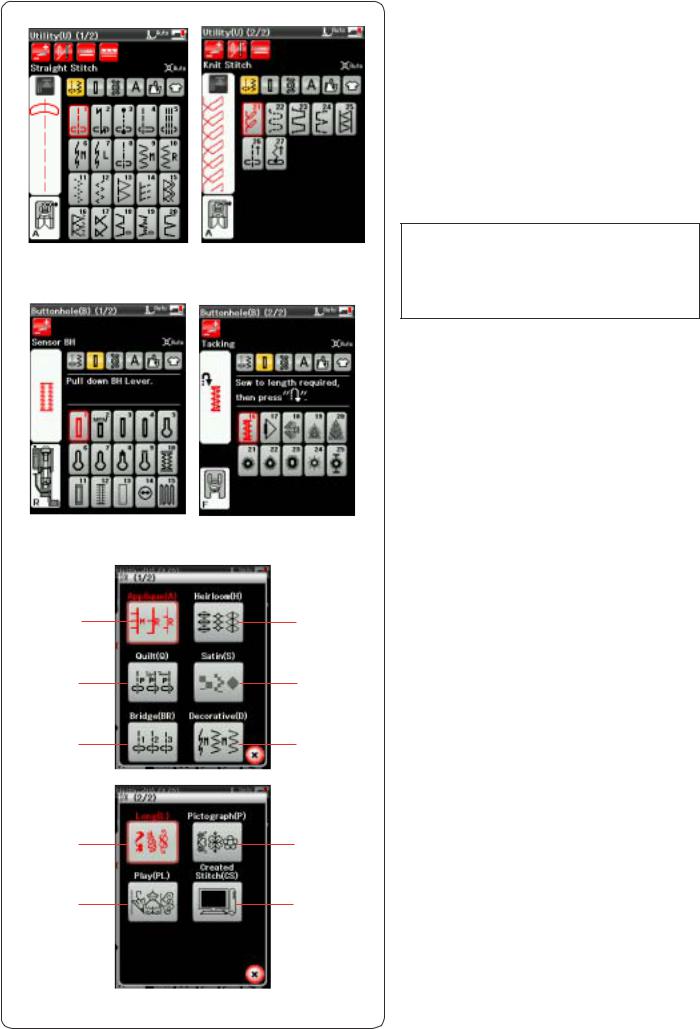
q
w
e
(A) |
(H) |
(Q) |
(S) |
(BR) |
(D) |
(L) |
(P) |
(PL) |
(CS) |
ORDINARY SEWING MODE
Ordinary Stitch Patterns
In the ordinary sewing mode, there are 6 categories available.
1.Utility stitches (U)
2.Buttonhole and specialty stitches (B)
3.Decorative and quilting stitches
4.Monogramming
5.Open file
6.Sewing applications
Press one of the icon keys to select the category.
NOTE:
In this manual, the pattern number refers to the initial for each group or category.
For example pattern #15 in the buttonholes and specialty stitches is referred to as pattern B15.
q Utility stitches (U)
You can select utility stitches for seaming, overcasting, blind hemming, basting and shell tucking.
w Buttonholes and specialty stitches (B)
There are various styles of buttonholes, button sewing stitches, darning, tacking, fly stitches and eyelets available in this category.
e Decorative and quilting stitches
This category consists of the following 10 groups. Applique stitches (A)
Heirloom stitches (H) Quilting stitches (Q) Satin stitches (S) Bridge stitches (BR) Decorative stitches (D) Long stitches (L) Pictograph stitches (P) Play stitches (PL) Created stitches (CS)
24

|
r Monogramming |
r |
You can program lettering as well as a |
|
combination of characters and symbol pat- |
|
terns. |
t |
t Open file |
|
You can open the pattern combinations saved |
|
in the machine’s internal memory and USB |
|
memory sticks. |
y
y Sewing applications
You can select the appropriate stitch for a specific sewing project and fabric type from the designated applications in this category.
25

Function Keys in Ordinary Sewing Mode
q w e r
q Adjust key
Press this key to open the manual setting window. You can adjust the settings of the stitch width, stitch
length, thread tension, cloth guide position, foot height for pivoting etc. (refer to pages 34-36).
w Twin needle key
Press this key to set the stitch width for twin needle sewing (refer to page 59).
The key will be grayed out if the selected pattern is not suitable for twin needle sewing.
e Drop feed key
This key is available only with the utility stitch group. Press this key to drop or raise the feed dog.
r Dual feed key
Press this key for dual feed sewing (refer to page 31).
|
|
|
|
t Program key |
t |
y u |
i o |
!0 |
Press this key to program a pattern combination. |
|
|
|
|
When this key is pressed, the cursor keys, delete key, |
|
|
|
|
memory check key and save file key will appear. |
y Vertical mirror image key
Press this key to sew a vertical mirror image of the selected pattern.
u Horizontal mirror image key
Press this key to sew a horizontal mirror image of the selected pattern.
The key will be grayed out if the mirror image is not available for the selected pattern.
i Delete key
Press this key to delete the pattern from the pattern combination.
o Memory check key
Press this key to view the stitch image of the entire pattern combination.
!0Save file key
Press this key to save the pattern combination as a file.
26
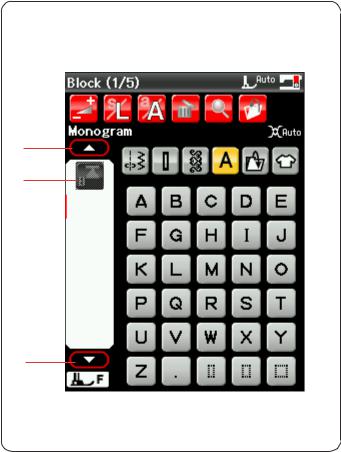
!3
!4
!3
|
|
|
!1Letter size key |
!1 !2 |
Press this key to select the letter size for monograms. |
||
|
|
|
!2Letter case key |
|
|
|
Press this key to select upper case or lower case for |
|
|
|
monograms. |
|
|
|
|
!3Cursor keys
Press one of the cursor keys to move the cursor up or down.
!4Startover key
This key will appear when you stop sewing.
If you stop sewing in the middle of a stitch pattern and wish to sew the pattern again from the beginning, press this key before you start sewing.
Press this key once to startover from the beginning of the current pattern, or press this key twice to startover from the beginning of the first pattern of the combination (refer to page 62).
27
